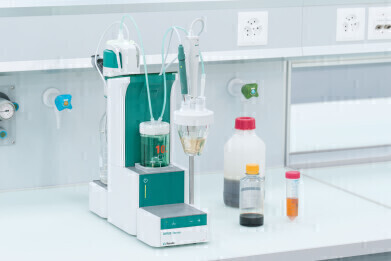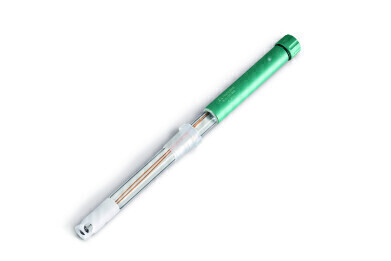-
 Thermometric titration is ideal for heavily contaminated samples, e.g., crude oil and other petrochemical matrices.
Thermometric titration is ideal for heavily contaminated samples, e.g., crude oil and other petrochemical matrices. -

Laboratory Products
Thermometric Titration Implemented in OMNIS
Apr 11 2023
Titration mode for ‘difficult’ samples added to modular titration platform from Metrohm
As universal as it may be, potentiometric titration is not a silver bullet: Highly aggressive media or heavily contaminated samples can quickly destroy a potentiometric sensor making it impossible to follow the chemical reaction in the sample solution and accurately determine the titration endpoint. Thermometric titration can often be the solution for measuring such samples; and this titration mode has now been implemented in OMNIS, the universal platform for titration by Metrohm.
Every titration reaction is either exothermic or endothermic. The temperature changes as the titrant and analyte react. When all the analyte has been reacted, a difference in the rate of temperature change indicates the endpoint.
Hence, thermometric titration follows the titration reaction and determines the endpoint using a thermometer with a very short response time and high resolution: The dThermoprobe from Metrohm has a response time of just 0.3 seconds and can measure temperature changes as small as 0.00001 degrees Kelvin. The endpoint of the titration is registered when the titration reaction has stopped and with it any change in temperature of the sample solution.
Customers can choose between a dedicated thermometric OMNIS Titrator or add the thermometric titration mode to any existing potentiometric OMNIS Titrator. For higher sample throughput, automation is possible utilising the OMNIS Sample Robot for unattended analysis of up to 175 samples at up to four dedicated workstations.
Typical application examples for thermometric titration are the determination of acid number in petroleum products (as per ASTM D8045), the phosphate or sulphate content in liquid fertilisers, or sodium content in foodstuffs. The advantages of thermometric titration in a nutshell:
- Fast – results within a minute
- Robust (HF resistant sensor) and therefore highly suited for aggressive media and heavily contaminated matrices (e.g., hydrocarbons, acid mixtures)
- One sensor for all applications
- No sensor calibration needed
- No sensor maintenance required (no diaphragm, no membrane, no electrolyte, sensor can be stored dry)
Digital Edition
ILM 49.5 July
July 2024
Chromatography Articles - Understanding PFAS: Analysis and Implications Mass Spectrometry & Spectroscopy Articles - MS detection of Alzheimer’s blood-based biomarkers LIMS - Essent...
View all digital editions
Events
Jul 28 2024 San Diego, CA USA
Jul 30 2024 Jakarta, Indonesia
Jul 31 2024 Chengdu, China
ACS National Meeting - Fall 2024
Aug 18 2024 Denver, CO, USA
Aug 25 2024 Copenhagen, Denmark
-(1)-(1).jpg)


24_06.jpg)













